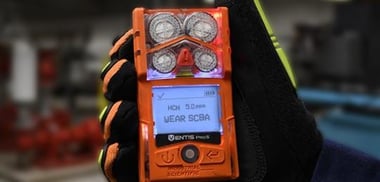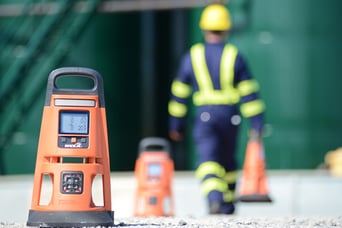For years, gas detectors have left users scratching their heads. Why are there negative readings? How do I know if a sensor is poisoned? Can I keep working through an alarm? Is this thing working?
Today, gas detectors are designed to make it easier for you to make safe decisions. New “smart” features not only provide clear information on the gas monitor’s status and sensors, but also tell you how to react when an alarm goes off. This takes away any guesswork about how to interpret the alarms and readings on your gas detector.
But with so many features available, it can be hard to know what truly matters. At the end of the day, what is going to make you safer at work?
Read on to learn the eight must-have features in a gas detector.
1. Monitors the Right Gases for Your Environment
Let’s start with the basics. If you’re looking for a gas monitor, it’s because there is a potential for gas hazards in your environment. Therefore, the monitor you choose needs to be able to detect those gases. Start by answering these questions:
- What atmospheric hazards are present at your site?
- How many gases you need to monitor at once?
- Are there any other gases that could cause cross interference?
Although there is no “silver bullet” gas monitor that will detect every possible combination of gas hazards, a personal multi-gas monitor is a good place to start. Look for sensor options to monitor the gases you’re most likely to encounter in your application or those that could pose the most danger should they be present.
2. Measuring Ranges that Match Your PPE Requirements
The National Institute for Occupational Safety and Health (NIOSH) recommends different levels of personal protective equipment (PPE) based on the potential hazard exposure in parts per million (ppm).
To accurately determine exposure, your gas monitors must be able to detect levels in accordance with the NIOSH guidelines for PPE. For example, if ammonia (NH3) could be present on your site, your gas detectors must be able to detect NH3 at levels greater than 300 ppm. However, many gas detectors can only measure NH3 from 0-100 ppm. This presents an issue. Without a device that can measure ranges greater than 300 ppm (or the NIOSH recommendation for your specific toxic gas), how do you know whether your PPE is providing adequate protection?
To avoid this issue, choose a gas detector that has a measuring range that matches PPE requirements. This is especially critical if you’re looking for a gas monitor to detect ammonia (NH3), hydrogen sulfide (H2S), sulfur dioxide (SO2), or carbon monoxide (CO).
3. Flexibility to Fit Your Application
If your gas detectors will be used for personal monitoring and nothing else, then this isn’t an issue. But if you’ll be working in confined spaces, conducting remote sampling, or just want a multi-tasking monitor, you should plan ahead. Many multi-gas monitors are available in both pumped (aspirated) and non-pumped models—but there’s a third option. Some gas detectors are compatible with slide-on pumps, allowing you to use one monitor across a number of situations. Although both pumped and non-pumped monitors can both be used for personal monitoring, slide-on pumps are a popular option because they reduce the weight of a monitor and an extend the battery life.
Pumped gas monitors allow you to pull air from an unknown and potentially toxic or combustible atmosphere to your monitor so that you can determine whether the area is safe. Pumps literally keep you out of harm’s way. Once you’ve assessed the air sample using a pumped gas monitor and have confirmed that it is clear of any toxic or combustible gases, you can enter the tested area and perform any work that needs to be done. However, a pump does not increase the gas monitor’s detection range or make it any more effective. Gas monitors can only detect gases that pass over the sensors. Having a pump on a gas monitor does not increase the amount of gas the sensors scan. Rather, the pump allows you to test the atmosphere at a distance from the monitor.
4. Status Alerts and Maintenance Reminders
Newer multi-gas detectors offer on-screen status messages you can view—before turning it on—to check that it’s ready to use. This is helpful if you share monitors with your peers and need to know whether it’s charged and what sensors are installed. Additionally, preprogrammed maintenance reminders, such as BUMP DUE or CALIBRATION DUE will pop up automatically on the screen so that you don’t need to guess whether your monitor is ready to use.
Think of these on-screen messages as the check engine light for your gas monitor—they make it easy to see your monitor’s status at a glance.
5. Alarm Action Messages and Full-Screen Alarms
When a gas detector goes into alarm, you need to instantly know how to act. It’s easier to make the safest choice quickly when monitors can communicate the correct action and reinforce safe behavior. Custom alarm action messages, like EVACUATE or WEAR SCBA correspond with alarm setpoints, making it easy to take the appropriate action in an emergency.
Full-screen alarms pair well with alarm action messages by using the entire display area for information on the sensor in question. This makes it easy to focus on the gas that is causing the alarm without the distraction of non-critical readings. More sensor information requires more interpretation and can lead to longer reaction times when every second counts.
6. Peer-to-Peer Connectivity
Peer-to-peer connectivity links nearby gas monitors to automatically share gas readings, panic alarms, man-down alarms, and more. Instead of guessing what to do when a gas monitor goes into alarm, peer-to-peer connectivity in gas detectors ensures that you get the information you need to act fast.
Whether a gas hazard, man-down, or panic situation causes an instrument to alarm, all peers in the connected group will instantly receive an alert on their own monitors showing who is in danger and why. Workers can even pick up readings from nearby area monitors so they know whether gas hazards are approaching their work area.
This feature is critical for confined space applications. NIOSH reports that more than 60% of confined space deaths are would-be rescuers who die trying to save a team member because the person inside can’t communicate about the dangers within. Connecting gas detectors through peer-to-peer connectivity gives everyone the information needed to make life-saving decisions.
7. Support for Live Monitoring
Think about what you’ll want and need your gas detectors to do in the next 4 to 8 years. The Industrial Internet of Things (IIoT) has led to a surge in connected gas detectors that will likely become standard within the next decade. If you’re not ready for connected safety just yet, consider monitors that have the technology capabilities built in, so if you decide to use live monitoring software later, your monitors are compatible.
Live monitoring is a quantum leap forward in gas detection because it allows safety managers to see when workers encounter hazards, what the hazard is, where they’re located, and whether the worker needs help. Live monitoring improves safety outcomes by giving safety managers the information they need to respond quickly in an emergency.
Live monitoring typically requires a special gateway, cellular, or wi-fi connectivity to relay information to the cloud. Some gas detectors are built so that you can add this capability over time should your needs change.
8. Easy Maintenance
Your gas detector is only as good as your maintenance plan. The bad news? Many companies don’t have one. In fact, our iNet® Control database shows the unfortunate truth that just 20% of users bump test each day. This is concerning, to say the least.
When time is limited and critical repairs take precedent, it’s not unusual for routine gas detector maintenance to be postponed. Subscription-based service programs allow you to lease gas detectors and pair them with docking stations to automate routine maintenance and eliminate repairs.
When a docking station senses a decline in a monitor’s performance, it automatically orders a replacement device to eliminate gas monitor downtime, the hassle of warranty claims, and the cost of replacement parts or spare monitors. Once you receive the replacement monitor, you send back the old one. With a program like this, you’ll know that your gas detectors are always working just as hard as you.
Need help choosing the monitor that’s right for you? Contact us for a free expert assessment of your gas detection needs.



